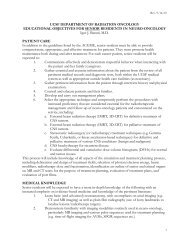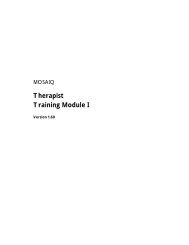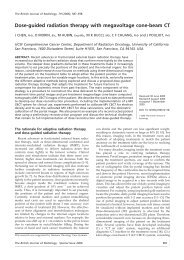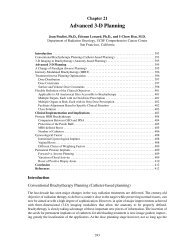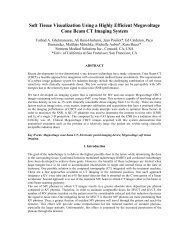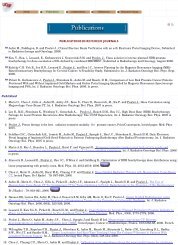MOSAIQ User's Guide - UCSF Radiation Oncology
MOSAIQ User's Guide - UCSF Radiation Oncology
MOSAIQ User's Guide - UCSF Radiation Oncology
Create successful ePaper yourself
Turn your PDF publications into a flip-book with our unique Google optimized e-Paper software.
CHAPTER 7: Image Management-ViewStation & Photos and Diagrams<br />
Using the Photos and Diagrams Utility<br />
You can acquire and display digital photos and diagrams as part of the electronic chart,<br />
using a digital camera or any of the wide variety of industry-standard devices to capture<br />
images that you can enter into the system. The Photos and Diagrams utility does not<br />
interface directly with image sources such as digital cameras.<br />
CAUTION<br />
The camera or scanner you use must be able to save images to disk in<br />
JPEG, PCX, BMP, or TIFF format. TIFF compatibility is limited, so we do<br />
not recommend devices that only support TIFF format. JPEG works best<br />
in most situations.<br />
We recommend that you set the camera resolution to the lowest<br />
resolution available (640x480 recommended). We also<br />
recommend that you use the compressed JPEG image format to<br />
keep the file sizes to a minimum. JPEG compression is variable<br />
and some camera settings can have different levels of control.<br />
Test different settings to find the optimal configuration for your<br />
facility.<br />
After importing the images, you must associate them with a treatment field or prescription<br />
site before you can use the images in the treatment set-up process.<br />
Importing Images Using Photos and Diagrams<br />
1. Scan or create using a scanner or digital camera, then save those images to the<br />
appropriate directory.<br />
2. Click File | Import/Export, then click Photos and Diagrams Import… to open the<br />
Photos and Diagrams Import dialog box.<br />
The Photos and Diagrams Import dialog box shows all the images in the specified<br />
directory. For this reason, you can work on multiple images at one time. For example, if<br />
you have five images for one patient and six images for another patient, you can process<br />
the five images for the first patient, then process the six images for the second patient, all<br />
without leaving the Photos and Diagrams Import dialog box.<br />
3. If the Directory field does not show the correct path to the directory with the images,<br />
click , select the appropriate directory, then click OK.<br />
4. In the Mark All as group, click Import if you wish to import all of the images. This<br />
changes the status indicators to green.<br />
5. In the Mark All as group, click Delete if you wish to remove all of the images. This<br />
changes the status indicators to red.<br />
6. If all the images are the same type, click adjacent to Image Type Selector field (located<br />
below the buttons) in the Mark All as group, then click the image type.<br />
7. In the Mark All as group, click Ignore if you wish to ignore all of the images. This<br />
changes the status indicators to yellow.<br />
Copyright 2010, Elekta Impac Software 149<br />
LUGMSQ0002/4.0/23-Sep-2010




